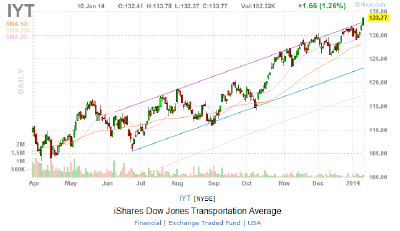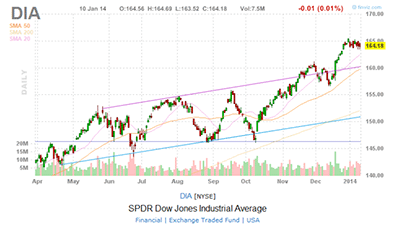“The January Barometer”
by Jeffrey Saut, Raymond James
January 13, 2014
It’s that time of year again when the media is abuzz with that old stock market saying, “so goes the first week of the new year, so goes the month and so goes the year.” Admittedly the January Barometer has a pretty good track record. To wit, according to the 2012 edition of the Stock Trader’s Almanac (as paraphrased by me):
Devised by Yale Hirsch in 1972, our January Barometer states that as the S&P 500 goes in January, so goes the year. The indicator has registered only seven major errors since 1950 for an 88.5% accuracy ratio. ... Including the seven flat-year [minor] errors (less than +/- 5%) yields a 77.0% accuracy ratio.
The Hirsch organization also notes (again, as paraphrased by me):
The last 38 up First Five Days [of the new year] were followed by full-year gains 33 times for an 86.8% accuracy ratio and a 13.9% average gain in all 38 years. ... Every down January on the S&P 500 since 1950, without exception, preceded a new or extended bear market, a flat market, or a 10% correction.
Given that historically the equity markets have a bullish tilt 67% of the time, the first week of the new year typically gives the January Barometer a bullish start for the month. Last year that first week of January sequence played in spades as the S&P 500 (SPX/1842.37) experienced the back-to-back 90% Upside Days of 12/31/12 and 1/2/13. As I wrote at the time, “The history of back-to-back 90% Upside days is that the SPX is better by (on average) 6.1% one month later 83% of the time, 12.8% higher three months later 100% of the time, and 18.9% improved six months later 100% of the time.” While last year we didn’t quite achieve some of those historic returns that were recorded since 1950, we certainly came close with the best yearly performance since 1997.
This year, however, we did not fare so well with the SPX losing 0.06% during the first five sessions of January. Still, according to the Stock Trader’s Almanac, what happens during the first week of the year is not important. What happens the entire month of January is important and that outcome remains to be seen. My sense remains the equity markets are merely consolidating the rally from the December 18th low of 1768 on the SPX and then are going to move higher into month’s end. Indeed, my measurement of the equity market’s internal energy level is back to a full charge, which can support a rise into early February and new all-time highs for the D-J Industrial Average (INDU/16437.05). Interestingly last week, almost unreported, the D-J Transportation Average (TRAN/7466.03) did just that by surging to a new all-time high. If the INDU can do the same this week, it would be yet another Dow Theory “buy signal” in the long string of such buy-signals we have experienced since the March 2009 lows (see the attendant ETF charts on page 3). As the technical analyst for the brainy folks at ChangeWave.com writes:
The most surprising technical feature of Thursday’s trade, which so far has gone unnoticed by other technicians, was the pop in the Dow transports. After lagging for days and testing its 20-day moving average, the Dow Jones Transportation Average jumped from support and almost broke to a new closing high [it did so on Friday]. Its MACD flashed a buy signal. Two weeks ago, I warned that a Dow Theory non-confirmation was possible because of a lagging Dow transportation index. Since then, the transports, which are closely watched by those who believe it has predictive economic value, broke to a new high and had a strong showing Thursday. This is a good indication that the bull is still on the field but taking a breather.
However, if such an upside surge takes place, it would probably leave the equity markets in a position of extreme exuberance often associated with short-term trading tops, as can be seen in the following chart:
As previously stated, the history of rallies like the one we have seen since the June 2012 “lows” (40%+) is that in the next three months the equity markets are due for a 5% - 7% pullback, as well as roughly a 10% -12% correction sometime over the next 12 months. Nevertheless, as repeatedly stated, such pullbacks should be viewed as buying opportunities given my ongoing belief we are into a secular bull market.
As for the economically sensitive TRAN that is telegraphing the stronger GDP we have been forecasting, in past missives I have featured such Strong Buy-rated names from our Transportation Services analysts like FedEx (FDX/$142.63), Kansas City Southern (KSU/$116.38), Genesee & Wyoming (GWR/$93.31), etc. This morning we are featuring Swift Transportation (SWFT/$20.84/Strong Buy). For further information please see our fundamental analysts’ reports.
Circling back to the January Barometer, every year at this time I not only address said indicator, but the “December Low Indicator” that I learned from my friend Lucien Hooper. It was back in the early 1970s, when I was working on Wall Street, that I encountered Lucien. At that time Lucien Hooper, then in his 70s, was considered one of the savviest “players” in this business. While known for many market axioms and insights, the one that stuck with me was Lucien’s “December Low Indicator.” It seems like only yesterday we were sitting at “Harry’s at the Amex Bar & Grill” having lunch when he explained it. “Jeff,” he began, “Forget all the noise you hear about the January Barometer, pay much more attention to the December low. That would be the lowest closing price for the INDU during the month of December. If that low is violated during the first quarter of the New Year, watch out!” For the record that closing low was 15739.43 and was recorded on 12/12/13.
The call for this week: I am in South Florida all week seeing institutional accounts, speaking at various events, and judging/sampling the speed bartenders’ competitions at Avenue D Jazz & Blues Lounge. If past is prelude the markets will do something in my absence. Since its high of 12/31/13, the INDU has drifted sideways. Near-term support exists at 16375 – 16400, yet I do not expect that level to be tested because all my Advance/Decline numbers confirm a healthy uptrend for the markets. Ditto, Cumulative Points Gained and Upside Volume. In fact, the only negative I see is the shrinking number of new 52-week highs, which is occurring mostly in the Basic Materials, Utilities, Energy, and REITs groups. This week the markets will endure Housing Starts/Permits (should be light of estimates due to weather), U.S. Business Inventories (should give back some of last month’s surge +0.03%e m/m vs. +0.07% prior), Core Retail Sales – Core PPI – Core CPI (all should be flat m/m), U.S. Industrial Production should be light due to weather, and auto plant slowdowns (+0.3% m/m vs. +1.1% prior), while NFIB Small Business Optimism and University of Michigan Sentiment reports should show improvement. As for last week’s punk employment report, I would pay absolutely no attention to it because it does not foot with all the other reports that are showing improvement. And, don’t look now, but credit spreads between Spanish and Italian yields versus German yields fell last week! Facing such news the preopening futures are weaker and the world markets are flat.
Charts courtesy of Finviz.

















